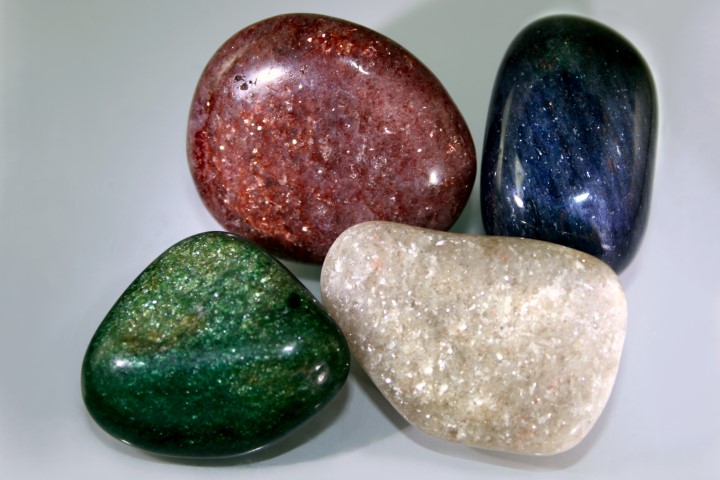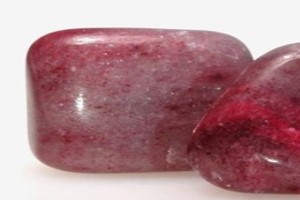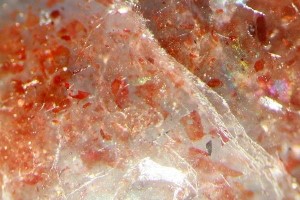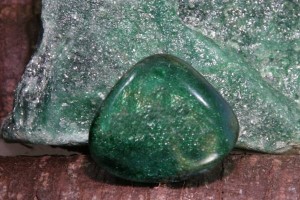
Genuine only with glittering inclusions: »Aventurine Quartz« in various colors
© K. Sieber, www.makrogalerie.de
The epithet "aventurine" stands for a particular light effect, that can be observed on the surface of both rock fragments and polished stones.
Aventurines show a multitude of glittering light reflections, which are clearly visible on polished stones.

Red color is brought about by the mineral piedmontite in this red »Aventurine Quartz«.
Photo: K. Sieber, www.makrogalerie.de

Thin hematite plates cause a glittering light effect in »Aventurine Feldspar« ("Sunstone").
Photo: K. Sieber, www.makrogalerie.de
This light effect is called "aventurescence" (ital. "a ventura" = by chance). It can potentially occur in all rocks that contain highly reflective minerals. Well-known are the following aventurescent rocks:
- Dumortierite Quartzite (trade name: blue »Aventurine Quartz«),
- Fuchsite Quartzite (trade name: green »Aventurine Quartz«),
- Hematite Quartzite (trade names: red »Aventurine Quartz«, orange »Aventurine Quartz« or outdated: "Eosite")
- Piemontite Quartzite (trade name: red »Aventurine Quartz«)
- Muscovite Quartzite (trade name: white »Aventurine Quartz«)
as well as: - »Aventurine Feldspar« (trade name: "Sunstone")
- »Aventurine Iolite« (trade name: "Iolite Sunstone")
- »Aventurine Zeolite« (e.g., Analcime with flaky inclusions of solid copper).
Artificial products such as aventurescent glasses are widespread sold with commercial names like "Goldstone", "Blue Goldstone" and "Green Goldstone".
To avoid confusion and mistakes it is indispensable to always use the name of the light effect together with the respective mineral name or name of the artificial product.
Green »Aventurine Quartz«
Green »Aventurine Quartz« is a fine to medium grained metamorphic rock, which consists of a multitude of interlocked quartz grains. Therefore, it is referred to as quartzite. The rock gets its green color from finely distributed green platelets of the chrome mica mineral fuchsite.
Quartzite is formed under high pressure from quartz-rich sediments (e.g., sandstones). During this process the quartz grains are recrystallizing in a closely conjoined pattern. The interwoven structure and the high quartz content of over 98 percent make the rock very resistant to environmental influences.
»Aventurine Quartz« may only be designated as such, if a glittering light effect is clearly visible to the naked eye. If this is not the case, the epithet "Aventurine" is inapplicable.




